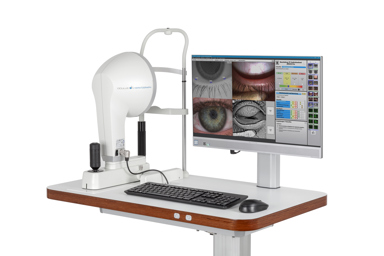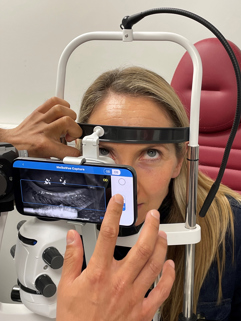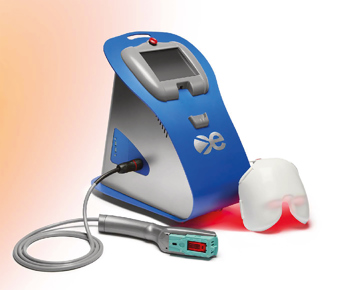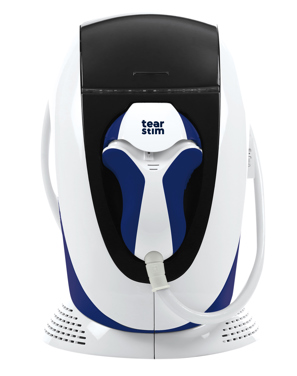
Idra from Essilor
Diagnostic
Essilor: Idra
The Idra from Essilor (pictured above) is said to allow eye care professionals to accurately capture tear film instability data, and then provide clearly presented metrics that are simple for the patient to understand. It also has an accompanying smartphone app, which allows patients to monitor their dry eye symptoms at home.
The device performs a full assessment of the ocular surface via a series of quick tear film tests, including the quality of tears and analysis of the meibomian glands, to classify the type of dry eye disease.
Paul Cumber, instruments director at EssilorLuxottica, says: ‘Dry eye is most certainly a growing area of opportunity for opticians and setting up a dry eye service will help differentiate and future-proof practices as well as helping patients to manage the condition.
‘The Idra imaging system is a compact and cost-effective piece of kit which provides strong evidence to support your choice of treatment, while helping the patient understand why that therapy is being recommended.’
Mainline Instruments: Oculus Keratograph 5M
The Oculus Keratograph 5M, which includes the Jenvis Pro Dry Eye Report, is said by distributor Mainline Instruments to offer leverage precision in diagnosing and managing dry eye conditions.
Mainline says the device benefits from advanced imaging technology and offers detailed analyses of tear film dynamics, meibomian glands, lipid layer thickness, and redness patterns.
All findings are recorded in accordance with medical products law and presented in a clear, visual printout for patient comprehension.
Zeiss: Zeiss Atlas 500
 Recently launched at 100% Optical, the new Zeiss Atlas 500 is described as a next-generation corneal topography system in a single compact workstation. The device is said to provide data-driven dry eye management, offering a comprehensive report on a variety of patient parameters that contribute to dry eye disease.
Recently launched at 100% Optical, the new Zeiss Atlas 500 is described as a next-generation corneal topography system in a single compact workstation. The device is said to provide data-driven dry eye management, offering a comprehensive report on a variety of patient parameters that contribute to dry eye disease.
The parameters include: meibography, including area of loss calculation and grading scale; ocular redness imaging and grading scale; tear meniscus height measurement; non-invasive tear film break-up time measurement; an ocular surface disease index questionnaire; and an optional osmolarity data input.
After performing the individual measurements of the dry eye indicators, users can pull them into the dry eye report overview. Zeiss Atlas 500 automatically displays the user-graded severity of the individual indicators using a traffic-light highlight system, and then allows you to assess all indicators at a glance.
Positive Impact: MeiboVue
UK Distributor Positive Impact says that MeiboVue offers dry eye practitioners a low-cost, yet high quality meibomian gland imaging solution. The device’s compact design is said to enable clinicians to quickly and easily check the condition of patients’ meibomian glands.
The company notes that the device can be carried anywhere to conveniently use as a handheld pre-screening device or slit lamp mounted in the consulting room as a practice’s principal meibographer, and its compact dimensions make it easy to capture high quality images while simultaneously everting the upper or lower eyelid.
MeiboVue also applies high tech Wi-Fi technology to transfer live video stream with the VisuDoc smartphone app wirelessly, which is said to enable the user to preview and capture meibomian gland images easily.
Bib Ophthalmic Instruments: Medmont Meridia Professional dry eye topographer
 The Medmont Meridia Professional dry eye topographer is said to extend the features of the previous Medmont E300 topographer by providing complete dry eye diagnostics, including a high end depth of focus colour anterior imaging facility, high quality fluorescein imaging, high definition meibomian gland imaging and videos for playback analysis.
The Medmont Meridia Professional dry eye topographer is said to extend the features of the previous Medmont E300 topographer by providing complete dry eye diagnostics, including a high end depth of focus colour anterior imaging facility, high quality fluorescein imaging, high definition meibomian gland imaging and videos for playback analysis.
Distributor BIB also notes that quick and easy tear meniscus measurements can be achieved, as well as full colour limbus-to-limbus topography.
The Professional model features a choice of dry eye grading scales and reports. This evidence-based approach with collaborative views and patient reports encourages patient engagement, leading to better diagnosis, patient compliance and better patient outcomes.
Hanson Instruments: Antares+
 The Antares+ from CSO is described by distributor Hanson as more than just a topographer in that it offers practitioners the ability to carry out full dry eye reports.
The Antares+ from CSO is described by distributor Hanson as more than just a topographer in that it offers practitioners the ability to carry out full dry eye reports.
The device can provide an Ocular Surface Disease Index (OSDI) questionnaire report, be used to take high resolution images with the 5MP camera, of both the limbal and conjunctival hyperaemia.
Additionally, it can provide meibomian gland analysis, tear meniscus analysis, non-invasive break-up time analysis and tear film analysis. The Antares+ dry eye report can then be used as a baseline and all future reports can be compared to measure any treatment
completed.
Grafton Optical: Moptim DEA Dry Eye Analyser
 The Moptim DEA Dry Eye Analyser is available in the UK from Grafton Optical and is said to quickly perform a comprehensive examination for complete dry eye diagnosis and management.
The Moptim DEA Dry Eye Analyser is available in the UK from Grafton Optical and is said to quickly perform a comprehensive examination for complete dry eye diagnosis and management.
As one of the smallest dry eye diagnostic devices on the market, the device’s compact design allows easy integration into a variety of clinical environments.
It can be operated as a stand-alone device, slit lamp mounted or handheld. Using the included adaptors, Grafton says the DEA can be attached to the majority of slit lamps, without affecting their use.
The DEA is said to provide complete dry eye diagnosis testing, as recommended by DEWS II. The built-in DEQ-5 questionnaire can be used in combination with objective findings to aid in diagnosis, and the Efron International Grading Scale helps to assess the severity of dry eye disease present.
Therapeutics
Topcon: Eye-light
Low Level Light Therapy (LLLT) is the advanced technology behind the Eye-light device, which is said to offer a completely painless treatment for conditions including meibomian gland dysfunction, dry eye disease and demodex.
LLLT is described by Topcon as a unique, light-based and patented photobiomodulation treatment that is based on technology originally employed by Nasa to treat astronauts in space.
The company says LLLT, by working on a cellular level, allows the cells to operate more efficiently and different wavelengths can be employed to target different problem areas.
The device also offers Optimal Power Energy (OPE) Intense Pulsed Light (IPL), which is a polychromatic light that stimulates the meibomian glands through its thermal pulses.
It is applied around the eyes and cheeks and stimulates the glands, improving the tear quality. Topcon says OPE IPL is the only pulsed light treatment in the world that does not require the use of gels.
Essilor: TearStim
The TearStim intense regulated pulsed light (IRPL) device from Essilor emits energy in the form of painless light pulses and heat and is applied to the skin below the eye.
The aim is to stimulate the parasympathetic nervous system supplying the meibomian glands, increase the secretion from the glands and contribute to restoring their normal activity. In addition, the quality of the secretion is improved, and the lipid layer of the tear film is stabilised.
Paul Cumber, instruments director at EssilorLuxottica, says: ‘The effectiveness of IRPL treatments such as TearStim can be enhanced further by using the Activa Home Eye Mask, which uses heat and massage to increase meibomian gland output, so eyes stay lubricated and symptom-free for longer.
'Currently, eye care professionals wanting to enhance their dry eye offering can purchase the IDRA diagnostic device or the Tearstim IRPL device and receive 50% off an Activa heat and massage mask, or if purchasing both, can get the Activa
free of charge.’
